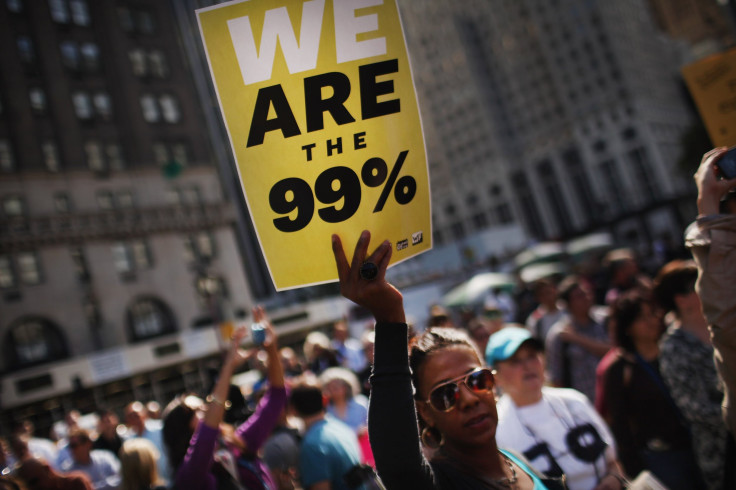Occupy Wall Street A Failure? OWS 2014 Marks Survival Of Brand With Blurred Purpose

Though its plan of attack was hazy, Occupy Wall Street took direct aim at corporations and financial structures considered “too big to fail.” If the protest movement's primary targets are still thriving three years later, does that mean OWS was too sprawling to succeed? Or can we credit Occupy with planting the seeds of a dialogue that may eventually lead to shifts in income inequality?
Since OWS first sprouted at Manhattan’s Zuccotti Park on Sept. 17, 2011, the decentralized opposition group has been routinely dismissed for its disorganization and lack of a core message. Within a year after the first Occupy encampment, news outlets were using the words “fizzled” and “failure” with notable regularity. And by this time last year, even many people who still associated with the group were expressing frustration over its wandering trajectory and leaderless makeup.
“I wouldn’t give them an ‘A’ for organization," Lillian Pollak, a protester who showed up at Zuccotti Park for the second anniversary, told International Business Times.
But while the thrill is gone for many once-passionate Occupiers who believed the movement would enact real change for the 99 percent of Americans facing an increasingly bleak economic picture, some say thinking about Occupy in terms of success or failure misses the point.
“How would we define success anyway?” asked Lisa S. Banu, a scholar and former design professor at Purdue University in Indiana, who studies Occupy’s branding strategies. “The movement didn’t necessarily have a particular teleological goal. It wasn’t like, ‘Once we achieve this, our movement has won.’ The point was to start a conversation.”
And if starting a conversation was the point, Banu said it’s a point that stuck. Occupy may have been mocked for its hippy-like encampments and festive drum circles early on, but it was instrumental in pushing income inequality into the national conversation, an issue that has seeped its way into every part of the culture since -- from viral videos to best-selling books like Thomas Piketty’s “Capital.”
Politicians both local and national have seized upon aspects of Occupy’s message as well. Making wealth disparity a core issue of his 2013 mayoral campaign, New York City’s then-public advocate, Bill de Blasio, vowed to tackle the “Tale of Two Cities” that he said defined the Big Apple during the Bloomberg years. A year earlier, issues like income inequality and class warfare dominated the 2012 presidential campaign. President Barack Obama continues to address these issues, whether it’s through pushing a higher minimum wage or discussing the decline of economic mobility. “I believe this is the defining challenge of our time,” he said in a 2013 speech.
The extent to which Occupy has influenced such political rhetoric is debatable, but it’s no small triumph that the very issues it set out to fight continue to permeate national politics three years later. “It’s hard to beat the bully pulpit of a U.S. presidency,” Richard Kaplan, a law professor at the University of Illinois College of Law, said. “If Obama’s talking about it then that has some significance.”
Of course, the problems Occupy was trying to tackle are bigger than simple rhetoric. As more and more data shows, income inequality is only getting worse, and it’s not expected to reverse anytime soon. “Most of the things that caused it to begin with are still very much in place,” Kaplan said. “If anything the same trends of globalization, returns to higher education and that sort of thing, have exacerbated. It’s not new. It’s been going on since even before Reagan.”
Amid its congested messages and image problems, Occupy’s most salient feature has always been basic branding -- from its effective use of hashtags and memes to its populist catchphrases like “We Are the 99 Percent.” It’s a strategy that was brought into focus by Kalle Lasn, co-founder of the anti-consumerism magazine Adbusters, who registered the domain OccupyWallStreet.org in the summer of 2011 and used social media to build a buzz around the first Occupy Wall Street encampment. The Occupy brand has since become an international franchise.
In a paper published on Academia.edu in April 2012, Banu explored Occupy’s successful approach to branded anarchy, a concept she admits sounds oxymoronic on its face. “How do you brand a grassroots movement?” she said. “How do you give it a logo, when it’s supposed to be anti-logo to begin with?”
A protest celebrating Occupy’s third anniversary is planned for Zuccotti Park on Wednesday, although how many people will actually show up is anyone’s guess. The folks at Adbusters haven’t abandoned the cause either. They’re calling Occupy’s third anniversary “World Revolution Day,” and as usual they haven’t been very specific on what that means. The slogan this time around is “What Will You Do?”
It’s a good question -- for people and for protest movements.
Got a news tip? Email me. Follow me on Twitter @christopherzara.
© Copyright IBTimes 2024. All rights reserved.




















